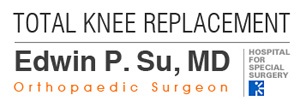- I’ve heard that recovery from a knee replacement is difficult. Why is that?
- How long will I need pain medication?
- How much motion will I have after TKR surgery?
- Will I be able to kneel after TKR?
- My knee range of motion is worse than before surgery. Should I be worried?
- I have been told that I need a manipulation under anesthesia. What is that?
- I had a manipulation under anesthesia, and now my knee hurts more. Please explain.
- What activities will I be able to perform after recovering from TKR?
- Do I need a special card to tell the airport screeners that I have a metal implant?
- Can I get an MRI?
- When can I shower?
- When should I go to outpatient therapy?
- When can I drive?
- I feel “clicking” inside the knee, is this normal?
- I am experiencing a lot of swelling, is this normal?
- My thigh, knee, and calf hurt. Is that normal?
- Can I work out in the gym?
- When can I return to work?
- When can I go to the dentist?
- Can I travel?
I’ve heard that recovery from a knee replacement is difficult. Why is that?
The knee is a highly sensitive area with a lot of nerve endings; therefore, any trauma to this area, whether you fall on your knee or have surgery performed, will be painful. Also, the knee is prone to swelling after surgery, which will make the knee feel stiff and tight. Scar tissue also commonly forms after knee replacement surgery, so it is important to get the knee bending immediately after surgery. Unfortunately all of these factors can add up to a difficult recovery and the need for pain medication to help accomplish your rehabilitation goals. Dr. Su uses many techniques to reduce the pain, swelling, and stiffness that you may experience after surgery.
How long will I need pain medication?
Every patient will be different in this regard. Initially after surgery, pain medication will likely be need quite regularly in order to combat the pain from surgical trauma. After a couple of weeks, then pain medication will likely be needed at certain intervals during the day to assist in moving around. Eventually patients transition to needing pain medication only before physical therapy, in order to help achieve the goals of therapy. Most patients will “turn the corner” at the 4-6 week mark, finding decreased pain and stiffness in the knee.
How much motion will I have after TKR surgery?
The best predictor of range of motion (ROM) after surgery, is the range of motion before surgery. Because bending and straightening the knee require ligaments, tendons, and muscles to glide and lengthen, if the knee hasn’t done this for a while, these structures may lose this gliding ability. In general, knee ROM will improve after surgery to the point of being able to sit in any chair, climb stairs, and ride a bicycle.
Will I be able to kneel after TKR?
Yes, once you have regained your range of motion and your muscle strength, you should be able to kneel. This may take up to a year after surgery. It is always advisable to kneel on something padded in order to decrease the pressure upon the incision.
My knee range of motion is worse than before surgery. Should I be worried?
It depends on at what timepoint you are currently. Immediately after surgery, the knee is swollen and painful, so ROM is certainly decreased compared to preop. It should increase gradually as time passes, swelling decreases, and PT is instituted. Generally, patients should have over 90 degrees of flexion by 6 weeks, and achieve their full ROM by 3 months postop. If you are having trouble regaining your motion, you may need a manipulation under anesthesia to achieve the desired ROM.
I have been told that I need a manipulation under anesthesia. What is that?
A manipulation under anesthesia is a procedure to break up scar tissue within the knee. Just like your physical therapist is attempting to do through his/her treatments, the goal is to improve your motion with force. However, it would be too painful without anesthesia. A MUA will numb your knee with the same anesthesia as done for your surgery, and Dr. Su will break up scar tissue by gently bending your knee with force. An MUA should be performed within 3 months of the original surgery, for the best results.
The MUA is an outpatient procedure, done without an incision. Patients are generally able to go home that same day, and restart their outpatient PT the next day.
I had a manipulation under anesthesia, and now my knee hurts more. Please explain.
An MUA does break up scar tissue binding up the knee, so it will cause bleeding when these bands of scar tissue are broken. I consider this taking one step backwards in order to take two steps forwards. The ultimate goal is to increase your ROM; initially after the MUA you may have more pain, but eventually the knee should regain the motion more quickly than after the original surgery.
What activities will I be able to perform after recovering from TKR?
The goals of knee replacement surgery are to alleviate pain and return you to activity, while lasting as long as possible. To this end, I recommend the avoidance of impact activities such as running or jumping. Patients are able to walk, hike, dance, swim, ride bikes, play golf, and play tennis.
Do I need a special card to tell the airport screeners that I have a metal implant?
You do not need a card to get through the airport; however, your implant will likely set off the metal detector. In this day and age, you will need to be hand-screened, so please leave extra time when you travel. We do provide an implant card for your convenience, which will be available postoperatively.
Yes, MRI are perfectly safe with a TKR implant. An MRI in the area of the knee implant, however, will not yield good pictures because of artifact created by the metal. MRI of a knee replacement should be performed at a facility with experience with techniques used to suppress the metal artifact.
You can shower as soon as you get home as long as you cover the incision with a waterproof dressing. You can use saran wrap to encircle the knee incision and tape the edges at the top and bottom. You should not immerse the incision under water. If the incision gets a little wet, just pat it dry.
When should I go to outpatient therapy?
I like to see you in follow up before you go as an outpatient; that way I can tailor your PT to what you need. However, if you feel that it is essential that you begin outpatient PT right away, you can call my office and we will provide a prescription and a list of places. Generally patients go to outpatient PT at 6 weeks postop, after I see you.
You should not drive as long as you are taking narcotic pain medication. For most patients, this will be at or around the 6 week postoperative mark.
I feel "clicking" inside the knee, is this normal?
The clicking is a result of the artificial parts moving against one another; this is completely normal in all artificial implants. It should not be painful and eventually you will get used to it.
I am experiencing a lot of swelling, is this normal?
Fluid can accumulate in the legs due to the effect of gravity. It is not unusual that you didn’t have it in the hospital, but it got worse when you went home (because you are doing more!) To combat this, you should elevate your legs at night by lying on your back and placing pillows under the legs so that they are above your heart. There are also TEDS stocking (the white stockings from the hospital) that you can put on during the day – have someone help you on with them in the morning, use them during the day, and then take them off at night. If you did not get the TEDS from the hospital, you can purchase knee high, medium (15-20 mm Hg) compression surgical stockings at most drug stores.
My thigh, knee, and calf hurt. Is that normal?
Yes, your leg is twisted completely around during the surgery, so it is expected that you have soreness up and down your leg.
You can go to the gym and resume upper body workouts, as long as the knee is in a non-loaded position (you should be sitting, not standing, when using weights).
It depends on your occupation. It is never a mistake to take more time off in the beginning of your recovery, as it will give you time to focus on your knee. I recommend taking at least 6 weeks off for a single TKR, and 8-10 weeks for a double. Keep in mind that you may still be using a cane and it may be difficult to commute. Many patients take 3 months off from work after surgery so that they may concentrate on their recovery and obtain the best results.
Please wait until 3 months after surgery, as the knee is still healing and there is increased blood flow to this area.
In general, I like to see you before you fly. If you are traveling by car, you should be sure to take frequent breaks so that you don’t feel too stiff when getting up. On an airplane, I like you to wear compression stockings (if within 1 month postop), and take a couple of walks during the flight. Having an aisle and bulkhead seat will help you get more space.


